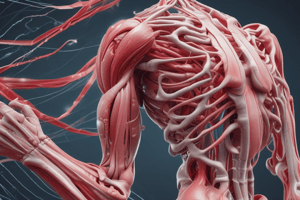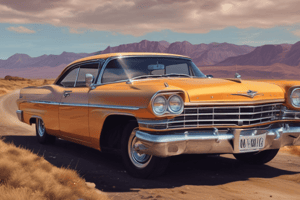Podcast
Questions and Answers
What are the primary proteins found in muscles responsible for contraction?
What are the primary proteins found in muscles responsible for contraction?
- Actin and myosin (correct)
- Myoglobin and hemoglobin
- Keratin and collagen
- Fibrinogen and thrombin
Which theory, described by Hugh Huxley and Andrew Huxley in 1953, involves the sliding of thick filaments over thin filaments during muscle contraction?
Which theory, described by Hugh Huxley and Andrew Huxley in 1953, involves the sliding of thick filaments over thin filaments during muscle contraction?
- Crossbridge Theory
- Motor Unit Theory
- Sliding Filament Theory (correct)
- Sarcomere Theory
What is the process called when myosin heads bind to actin sites during muscle contraction?
What is the process called when myosin heads bind to actin sites during muscle contraction?
- Mitochondrial Activation
- Fibrillation
- Endocytosis
- Crossbridge Cycling (correct)
What determines the strength of muscular contractions by coordinating the activity of individual muscle fibers?
What determines the strength of muscular contractions by coordinating the activity of individual muscle fibers?
Where do muscles receive electrical signals from neurons via synapses?
Where do muscles receive electrical signals from neurons via synapses?
Flashcards are hidden until you start studying
Study Notes
Exploring Physiology and Muscle Contraction in Biology
Muscles are dynamic structures responsible for movement, maintaining posture, and generating force throughout our bodies. To unpack the fascinating details behind muscle function and the processes driving physiology, let's delve deeper into the mechanics underlying muscle contractions and the fields of biology and physiology.
Muscle Contractile Proteins
Muscles consist primarily of proteins called actin and myosin, forming thin filaments and thick filaments, respectively. These proteins interact through crossbridges—myosin heads binding to actin sites during contraction—and release during relaxation. Crossbridge cycling generates the sliding filament theory described by Hugh Huxley and Andrew Huxley in 1953.
Mechanisms of Muscle Contraction
Contractions occur due to two primary mechanisms:
- Sliding Filament Theory: Thick filaments slide over thin filaments thanks to myosin head movements, causing sarcomeres to shorten and resulting in muscle fibers contracting.
- Crossbridge Cycling: During each cycle, a myosin head binds, pulls, and releases an actin site, allowing muscles to generate continuous tension.
Coordination between motor units determines the strength of muscular contractions.
Neuromuscular Junction and Excitatory Processes
Muscles receive electrical signals from neurons via synapses known as neuromuscular junctions. Acetylcholine, released from presynaptic axonal endings, binds to nicotinic acetylcholine receptors on postsynaptic membranes, creating ion channels that permit sodium and potassium influx and initiating muscle action potentials.
Regulation of Muscle Contraction
Various factors influence muscle contraction speed and force production, including:
- Temperature
- pH balance
- Presence of calcium ions
- Nervous system input
Muscle length, fiber composition, and fatigue levels also affect performance.
Summary
Understanding muscle contraction provides valuable insights into human movement and athletic achievement. By studying physiology's molecular mechanisms, we gain knowledge essential for improving exercise regimens and treating various diseases.
Studying That Suits You
Use AI to generate personalized quizzes and flashcards to suit your learning preferences.




